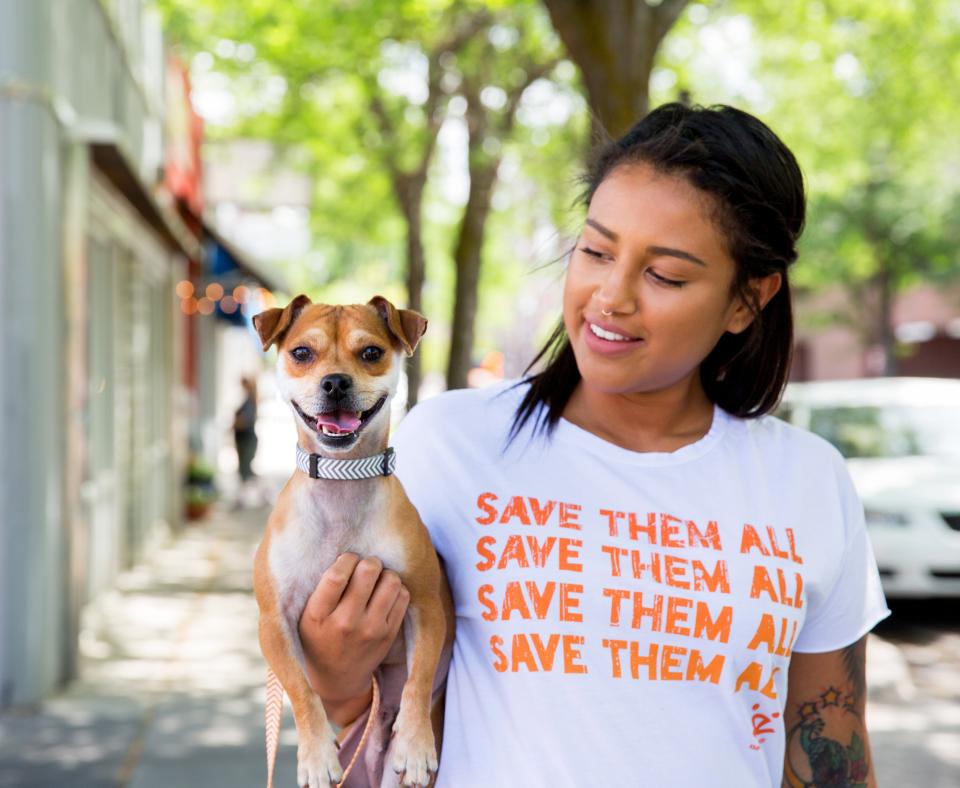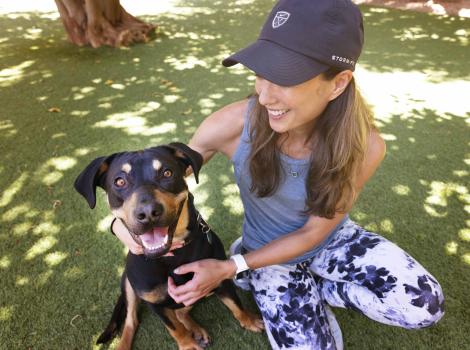Magic of playgroups unveils dogs’ hidden sociability

Amora, a 35-pound, black-and-white pup, and Dingo, a 50-pound shepherd mix, were stressed out. Amora was reactive in her kennel and seemed extremely unsocial, while Dingo was constantly spinning around in his kennel and was reactive to any humans approaching his space.
The staff at the Galveston County Animal Resource Center were understandably skeptical about Amora and Dingo’s chances of being adopted. And so, when Aaron Caldwell of Dogs Playing for Life (DPFL) arrived to give a five-day seminar on playgroups, he was especially interested to meet Amora, Dingo, and other dogs whose chances at being adopted appeared slim.
The seminar — which included 13 Houston-area animal shelters and was sponsored by Best Friends Animal Society — is one of many ways that we work with shelters around the country. Providing this kind of shelter staff training is one of the ways Best Friends is helping shelters reach no-kill by 2025.
[Kansas animal shelter staff sees dogs in a new light]
"We are so thankful to Best Friends and DPFL for bringing shelters together to train in this program,” says Alexandra Sierra, animal services manager with Galveston County Animal Resource Center, which hosted the event. “The seminar gave us the opportunity to not only learn how to safely run playgroups, but it helped us learn a great deal about our own dogs and their behaviors.”
DPFL, which has provided training sessions for nearly 300 shelters nationwide, teaches playgroups as an effective and efficient way to improve dogs’ quality of life if they land in a shelter and ultimately to help them get adopted. When a shelter staff runs playgroups, it gets dogs out each day to interact with each other, helps them expend excess energy, and counters common anxiety and frustration sometimes caused when they must stay in a kennel.
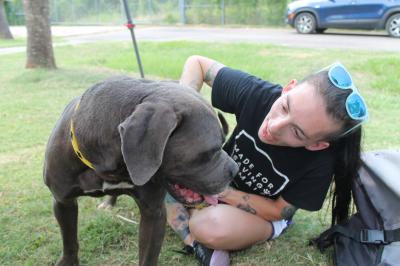
A new concept for many shelters
While many shelters utilize some form of enrichment and basic training for dogs, utilizing playgroups as part of a shelter’s daily operational schedule is a fairly new concept.
“Some shelters are hesitant (about playgroups) because barrier and leash reactivity may indicate to caregivers and volunteers that dogs are unsocial,” says Aaron. “But that stuff doesn’t tell us anything about sociability. And when they see us working with those same dogs in playgroups, they are stunned. They can’t believe their own dogs are that social.”
Lack of staffing can be another obstacle to shelters running playgroups. But Aaron says even that can be overcome. “You have to get dogs out of the kennels to clean, and once you do that, half the work (getting them to the play yard) is done,” he says. “By showing shelter staff how to do that, we have an opportunity to change their minds about their own capacity to do playgroups.”

13 shelters attend group presentation
Because many shelters require all hands on deck seven days a week to care for the animals, many of them are unable to shut down for a day to attend an all-day seminar. With that in mind, Best Friends searched for an alternative that would allow more shelters to attend.
“We talked with DPFL about presenting to a number of shelters over the course of a week,” says Deyra Galvan, Best Friends manager of lifesaving programs in Houston. “We arranged to hold most days in the yards at the Galveston Animal Resource Center. And, as it turned out, we had 13 shelter partners on-site with us.”
This extended session was different from anything done previously by DPFL. “It was the first time I’d done that many shelters, and it was a bit faster-paced,” says Aaron. “But we were able to get many communities involved, which was a huge benefit.”
Kymee Bair, behavior and enrichment manager at the Houston Humane Society, didn’t have to be convinced to come down for the sessions. “I had done some research on DPFL when I was hired on,” she says. “But I was a team of one. I couldn’t do playgroups by myself, so I wanted to go and see if we could figure out how to do it at our shelter.”
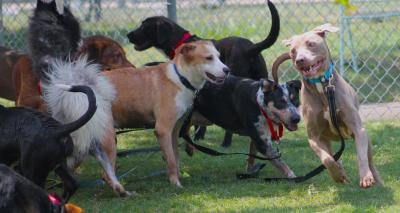
Training reveals Amora’s social side
Seeing Aaron work with dogs from the Galveston shelter was eye-opening. “Heck yes I was impressed,” says Kymee, who watched both Amora and Dingo take part in playgroups that included approximately 120 dogs during the week-long training.
Kymee knew nothing of Amora’s past issues of being reactive in her kennel. All she saw was how sweet Amora was in playgroups, which enabled her to come out of her protective shell and show her social side. In fact, she did it so well that Kymee was happy to take her back to Houston Humane. “She was their rock star out there,” Kymee says. “She was super social. And we took Dingo, too.”
Houston Humane, which previously focused on kennel enrichment and basic obedience training with their dogs, has reaped benefits since implementing playgroups. They are seeing dogs show less kennel stress and leash reactivity and, best of all, increased adoptions.
“We had a dog named Mystery who was always spinning in his room,” Kymee says. “He would bounce off the wall, spin in a circle, and he was incredibly reactive. But after a month in playgroups, his spinning decreased significantly. He stopped being reactive on leash. He kept getting better so that people coming to the shelter started saying ‘that dog looks pretty cool.’ It wasn’t long before he was adopted.”

Houston playgroups in action
Using playgroups has paid other dividends for Houston Humane. Getting staff and volunteers to participate in playgroups before the seminar was often difficult, Kymee says, because of how dogs behaved in their kennels.
“Following the seminar, I’m wondering just how I’m going to make this work,” she says. “But during our first session after we got back, our entire staff and volunteers were out there. Now we have a solid core of six volunteers to run or participate in playgroups, and we’re running them five days a week.
“We’ve found that with care and planning you can even do playgroups with one person. Where there’s a will, there’s a way. Plus, I have such a supportive management team. My shelter director is a huge advocate to have playgroups going as much as we can. People are surprised once they realize just how social these dogs are in playgroups.”
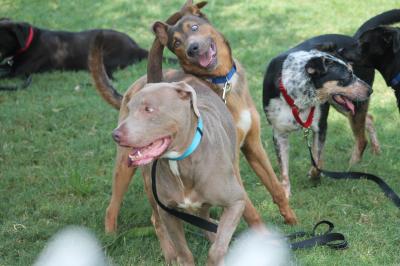
The payoff: More lives saved
Like Amora and Dingo, a 4-month-old Chihuahua named Penny was another seemingly troubled soul taking part in the seminar. Everyone thought she was completely unsocialized.
“They said she would try to bite anyone who came near,” says Reagan Daughtry, a Best Friends staff person in Houston who helped organize the event. “I spent about an hour trying get a collar on Penny, so she could get into a playgroup. We finally succeeded, and she was a little nervous in her first playgroup session. But she did fine.” (A collar was necessary for Penny for attaching a drag leash, which made it easier to catch her once she was out in the yard or in case of an emergency.)
One look at Penny in playgroups was enough for Kymee, who took her back to Houston Humane. Over the next three weeks, the little dog who could not walk on leash and didn’t allow anyone to pick her up began to change. In playgroups she saw people giving other dogs attention and learned that people aren’t so bad after all. Not long after arriving in Houston, Penny was adopted.
Amora, Dingo, and Penny: Three animals with uncertain futures had their lives saved and futures reborn — all because of playgroups.
[Playgroups at Arkansas shelter let a shy dog shine]
“We were surprised about how friendly our Galveston dogs were in playgroups, and it was wonderful to see them play until their hearts were content," says Alexandra. “When Houston Humane noticed our struggles getting certain dogs adopted, we told them about Amora and how we didn’t think she’d do well in playgroups. But, man, were we wrong! I was so shocked and ecstatic that she did so well and Houston Humane fell in love with her. Since then, Houston Humane has been pulling dogs from us and putting them into their program. We couldn’t be happier.”
Reagan says the event was a rousing success, and the feedback has been all positive, with many of the seminar participants already implementing playgroups into their daily operations. "We held one session in LaPorte, and the day after we left, they started with playgroups. The City of Baytown has started to utilize playgroups in their municipal shelter.”
“This program is lifesaving,” Kymee says. “We have saved so many dogs because of playgroups. We get them out in the yard, and it turns out they are not unsocial. In fact, since the seminar, 110 of our playgroups participants have been adopted. The more we do, the more the dogs enjoy it and the more lives we are saving as a whole.”

Let's make every shelter and every community no-kill by 2025
Our goal at Best Friends is to support all animal shelters in the U.S. in reaching no-kill by 2025. No-kill means saving every dog and cat in a shelter who can be saved, accounting for community safety and good quality of life for pets.
Shelter staff can’t do it alone. Saving animals in shelters is everyone’s responsibility, and it takes support and participation from the community. No-kill is possible when we work together thoughtfully, honestly, and collaboratively.



